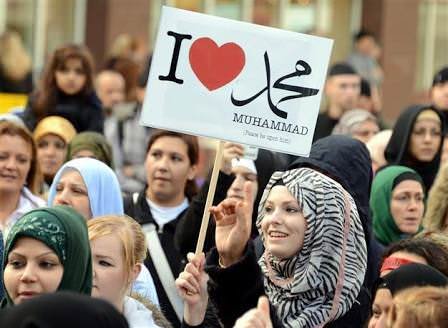
A report published by a US think tank on Thursday projects that Muslims could make up between 9 and 20 percent of the German population by the middle of the century.
The Pew Research Center, in a study entitled "Europe's Growing Muslim Population" issued three projections for an increase in Germany's Muslim population based on different migration scenarios - zero arrivals, "medium" flows and "high" migration.
It projected that, if all migration into Germany stopped immediately, Muslims could make up nine percent of the overall population by 2050 due to higher fertility rates among Muslims than in the wider German population. Muslim women have on average 1.9 children compared to 1.4 in the wider population, the study says.
In a situation in which refugee flows to Germany stop but regular migration continues, the study says Muslims could comprise 11 percent of the German population by the middle of the century.
In the “high” migration scenario, the researchers estimate what the German population could look like if refugees continue to arrive in the numbers seen between 2014 and 2016. In this case they estimate that one in five people in Germany would be Muslim in 2050.
The authors of the report also noted that refugee flows had already begun to decline in line with EU efforts to curb arrivals, suggesting the third outcome was unlikely.
While making clear that the numbers are projections rather than definite predictions, the study claims to provide the first estimates of a change in the demographic makeup of Germany and Europe since large scale refugee arrivals between 2014 and 2016.
Germany registered close to 700,000 refugees between mid 2014 and mid 2016, around 86 percent of whom were Muslim. Meanwhile during the same period a similar number of regular migrants arrived in the country, 40 percent of whom were followers of Islam.
The Pew studied also projected that Europe will become more Muslim over the next three decades.
If all migration into Europe stopped immediately, the Muslim population of the 28-member European Union plus Norway and Switzerland would rise to 7.4 percent from 4.9 percent in 2016, the study estimates.
Europe received more than one million migrants and refugees in 2015, according to figures from the UN's refugee agency.
Most arrived from Muslim-majority nations and some right-wing political parties have upped their anti-Muslim rhetoric in their wake.
Under that scenario the proportion of people who self-identify as Muslim was projected to more than double to 11.2 percent of the population in 2050.
The third model was based on refugees, most of them Muslim, continuing to arrive in the record numbers seen in 2015 and 2016.
Under that scenario Muslims would account for 14 percent of Europe's population in 2050, which Pew said was "still considerably smaller than the populations of both Christians and people with no religion".
The report also highlighted the role of migration in stemming population decline in Europe.
In the absence of further migrants the population was projected to shrink from 521 million in 2016 to 482 million in 2050.
Under the "medium" scenario, it would rise to 517 million people, while in the "high" migration scenario would take it to 539 million.
Pew's projections showed Europe being unevenly affected by migration.
If arrivals halted altogether, France - which was home to an estimated 5.7 million Muslims (8.8 percent) in 2016 according to the report -- would continue to have Europe's largest Muslim community.
Under the "medium" scenario, Britain - the top destination for non-refugee Muslims migration - would pass out France while under the "high" scenario the mantle would pass to Germany, which has received over 1.5 million refugees in the past two years.

